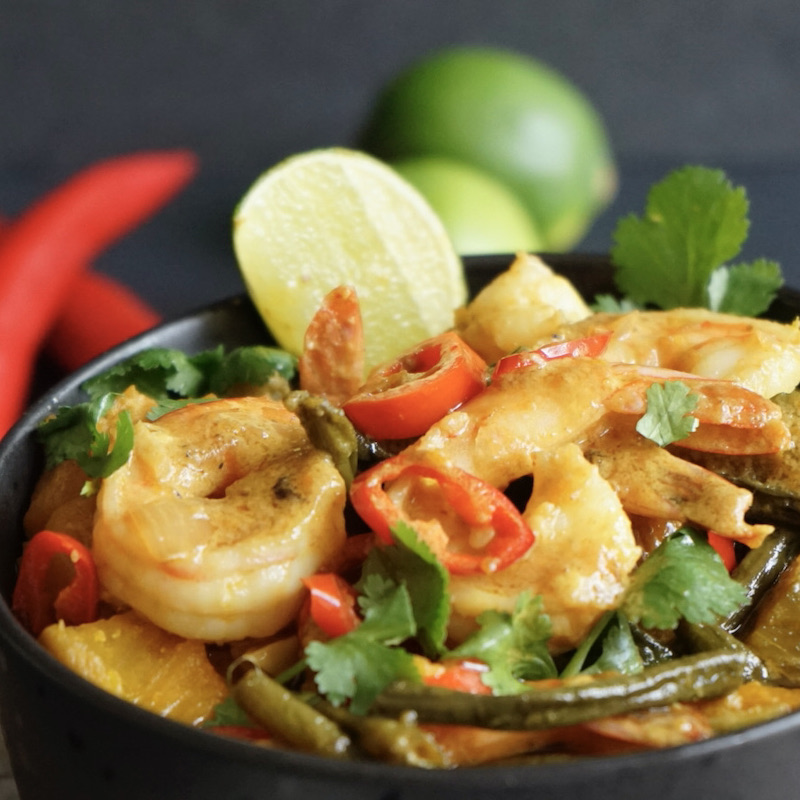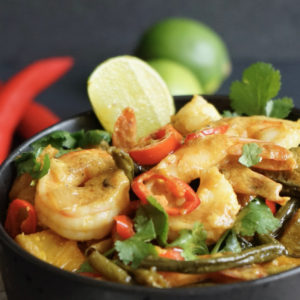Coconut Shrimps and Veggie Stew

(Grandma’s Pinakbet)
I love eating all kinds of vegetables. Growing up in the Philippines, I never really experienced eating fast food as much as I experience here in the U.S. My grandma used to wake up before sunrise to go to the market to make sure she was first in line for the early delivery of fresh meat, vegetables, and seafood. I remember her carrying a basket full of kabocha squash, snake beans, bitter melons, garlic, and onions. I always get excited because I know she’s gonna make something delicious for dinner. Today’s dish is about remembering my grandma and her great-tasting recipe called “Pinakbet”. Although I jazzed up my recipe it still has the richness and combination of vegetables commonly found in Filipino cuisine.
follow us on social

what is pinakbet?
- “Pinakbet” is a Filipino dish with any type of protein and locally grown vegetables. It’s commonly cooked in a big pot, sautéing garlic and onion first. The common vegetables used in this dish are kabocha squash (kalabasa), bitter melon, snake beans, eggplant, and sometimes okra. Pinakbet is originated in the Ilocos region. Traditionally, Ilocanos make it with ginger, shrimp paste, and patis (fish sauce).
- Most of the ingredients can be found in your local Asian grocery store. I have also seen them at our regular grocery in the Asian aisle. For example, soy sauce, fish sauce, and oyster sauce, nowadays these ingredients are very accessible at your local market.

Here’s what you need to make this dish
NOTE:
This dish is my version of Pinakbet. You can use any protein you like or just leave it without and make it a vegetarian dish.
What I’ve done differently from the original Filipino pinakbet?
I love anything coconut. For this dish, I added coconut cream. I also used different types of spices, like turmeric for a nice golden color, curry powder, and coriander are great flavor enhancers especially if you’re using coconut cream. I believe these are the only ingredients that make it different. I forgot eggplant, honestly, I have them sitting in the fridge, and I got distracted and forgot to add them.
Kabocha Squash (kalabasa):
- Definition: With a sweet flavor, similar to a sweet potato or pumpkin, this Japanese squash is delicious and full of Vitamin C, iron, and beta carotene.
- How to peel and deseed: Use a sharp knife to cut the kabocha in half first (wear protective gloves to prevent accidents, be very careful). Then use a grapefruit spoon or a regular spoon to scrape off the seeds. Cut the squash again into smaller pieces. Use a vegetable peeler to feel off the skin. Then cut into bite-sized pieces.
Snake Beans:
- Definition: Also known as yard-long beans or asparagus beans, they originate from Southeast Asia. These beans will make dishes tastier with their sweet flavor and crunchy texture.
- How to cut the beans: Wash and trim both ends to get an even length. Then cut the strings of beans into at least 3″ long.
Shrimp Paste:
- Definition: You can count on shrimp paste to add zest and flavor to various Southeast Asian dishes. It is a fermented condiment made from crushed or ground shrimp.
- Where to find shrimp paste: You can get it at your grocery store in the Asian aisle. I bought the brand name “Bario Fiesta” this was my grandma’s favorite shrimp paste.
Fish Sauce:
- Definition: Often used in Southeast Asian cuisine, this tasty sauce is made from drained fermented anchovies.
- Is it very fishy in taste: Fish sauce of course tastes fishy and salty, also a bit funky but in a good way. It’s great with lime juice and other ingredients to help balance the flavor of your dishes. It’s mostly used for cooking and not so much by itself, and doesn’t make the dish taste fishy. I used the brand name “Three Crabs”
Bitter Melon:
- Definition: Bitter melon or bitter gourd is known for its sharp taste and antioxidants. It is often used in Asian stir-fries and similar dishes.
- How to deseed: Wash and trim both ends. Then cut in half, use a spoon to scoop out the seeds. Cut into even slices.
Red Chili:
- Definition: These chili peppers are also known as “hot peppers” are used to add spice to various dishes and to make delicious hot sauces and salsas.
- Are these chilis hot: I used “Red Finger Thai Chilis” they’re not very spicy. The larger chilis are milder in taste, almost similar to bell peppers.
Soy Sauce:
- Definition: Made by fermenting soybeans and wheat, soy sauce is salty, sweet, and savory all in one and is added to various Asian dishes to add a burst of flavor.
- How much soy sauce do I need: I only used 1/4 cup for this dish. Soy sauce gives great taste and full of umami flavor that naturally enhances the flavor of your dish. I also use a little bit of Oyster Sauce.
Spices:
Turmeric: In the same family as ginger, turmeric comes from the turmeric plant and is used in Asian cooking. Offering a pungent and peppery flavor, this spice also provides several health benefits, including being anti-inflammatory.
Coriander Powder: This powder originates from the seeds of the coriander plant. It has a sweet, citrusy taste and is often used in curry blends.
Curry Powder: Used often in Indian cooking, curry powder is made by mixing various spices, such as coriander, turmeric, red pepper, ginger, and more!
watch how to make it
subscribe

Coconut Shrimps and Veggie Stew
Equipment
- Big wide pot
- knife
- cutting board
- Grapefruit spoon
- Ladle
Ingredients
- 3 tablespoons vegetable oil
- 1 pound shrimp, deveined, peeled, tail on
- 1 yellow onion, sliced
- 4 garlic cloves, minced
- 1 teaspoon turmeric
- 1/2 teaspoon curry powder
- 1/2 teaspoon coriander powder
- 1/2 teaspoon red chili pepper flakes
- 1 bunch snake beans or string beans, washed, trimmed, sliced
- 1 tablespoon shrimp paste
- 2 bitter melons, washed, trimmed, deseed, sliced
- 1/4 cup soy sauce
- 3 tablespoons oyster sauce
- 1 tablespoon fish sauce
- Juice of one lime
- 2 cups kabocha squash, deseed, peeled, cut into bite-sized pieces
- 1 canned coconut cream
- 2 Thai red finger chilis, trimmed, sliced
Instructions
- Heat a wide pan with oil. Add the shrimps, cook for 30 seconds on each side or until they turn opaque. Set aside.
- Use the same pan. Add onion and garlic, saute for a minute or until the onions are translucent. Add turmeric, curry powder, coriander powder, and chili flakes. Continue stirring until combined.
- Add snake beans and shrimp paste, stir to combine. Add the bitter melons, soy sauce, oyster sauce, fish sauce, and squeeze lime juice. Constantly stirring, simmer for a minute or until veggies are tender.
- Add kabocha squash and coconut cream, stir, lower the heat, cover, and simmer for 3 minutes or until the squash is tender.
- Add the red Thai chilis and cooked shrimps, stir to combine. Continue to stir until well heated. Serve immediately with steamed rice.
Notes
- You can use a wok or wide pan to make sure all the veggies are evenly cooked
- You can also add fried tofu if you’d like to make this dish vegetarian
- I added oyster sauce for extra flavor
- You can either use coconut cream or milk. The creamed coconut of course is more creamy
- If you’d like to make the authentic Filipino Pinakbet, don’t add coconut milk, curry powder, coriander powder, but add eggplant and ginger. Add a little chicken or vegetable broth to jazz up the flavor.
 DID YOU MAKE THIS RECIPE? Tag us on Instagram @leanbellaskitchen and hashtag #leanbellaskitchen
DID YOU MAKE THIS RECIPE? Tag us on Instagram @leanbellaskitchen and hashtag #leanbellaskitchenequipment
get free one week meal prepping recipes

ABOUT JEN
Welcome to my virtual home. I’m a mom of two wonderful girls and a Community Education Culinary Instructor. I love to prepare and cook home-cooked meals. Cooking and planning your meals might sound like another chore added to your already long list of things to do. Believe me, I’ve been there. However, cooking and prepping meals will save you money, time, and you know what goes into your food. Definitely worth the effort. Read more…




